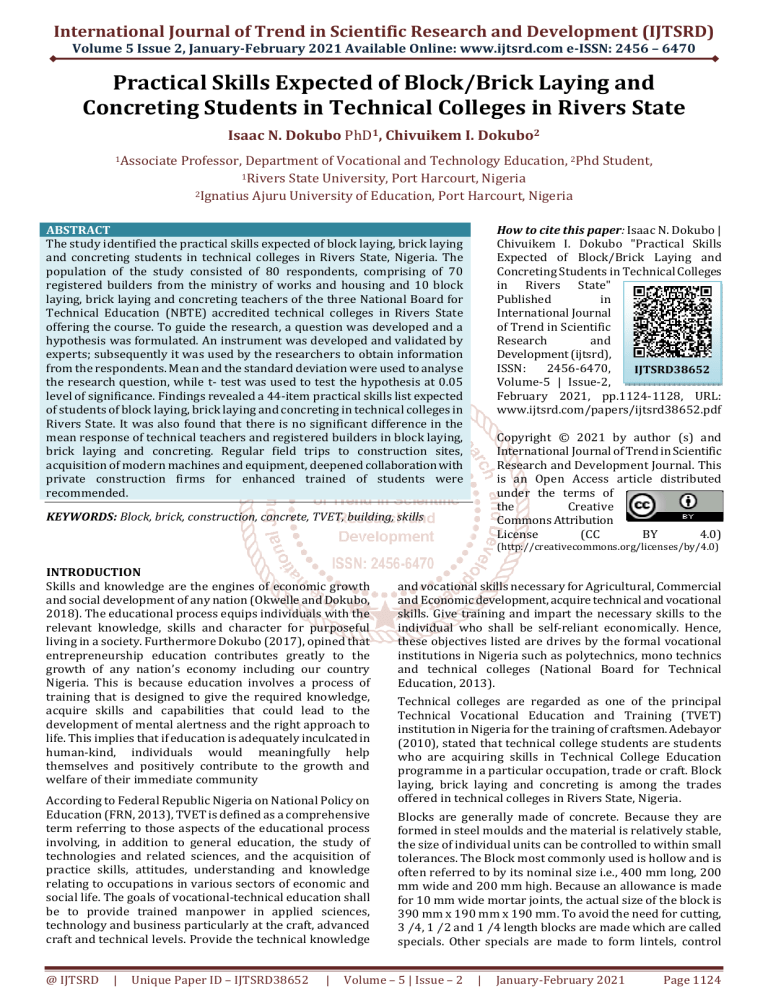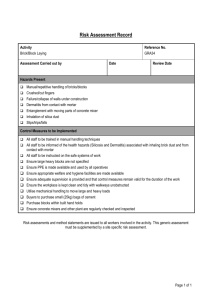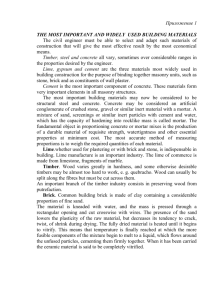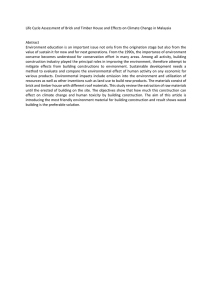
International Journal of Trend in Scientific Research and Development (IJTSRD)
Volume 5 Issue 2, January-February 2021 Available Online: www.ijtsrd.com e-ISSN: 2456 – 6470
Practical Skills Expected of Block/Brick Laying and
Concreting Students in Technical Colleges in Rivers State
Isaac N. Dokubo PhD1, Chivuikem I. Dokubo2
1Associate
Professor, Department of Vocational and Technology Education, 2Phd Student,
1Rivers State University, Port Harcourt, Nigeria
2Ignatius Ajuru University of Education, Port Harcourt, Nigeria
How to cite this paper: Isaac N. Dokubo |
Chivuikem I. Dokubo "Practical Skills
Expected of Block/Brick Laying and
Concreting Students in Technical Colleges
in Rivers State"
Published
in
International Journal
of Trend in Scientific
Research
and
Development (ijtsrd),
ISSN:
2456-6470,
IJTSRD38652
Volume-5 | Issue-2,
February 2021, pp.1124-1128, URL:
www.ijtsrd.com/papers/ijtsrd38652.pdf
ABSTRACT
The study identified the practical skills expected of block laying, brick laying
and concreting students in technical colleges in Rivers State, Nigeria. The
population of the study consisted of 80 respondents, comprising of 70
registered builders from the ministry of works and housing and 10 block
laying, brick laying and concreting teachers of the three National Board for
Technical Education (NBTE) accredited technical colleges in Rivers State
offering the course. To guide the research, a question was developed and a
hypothesis was formulated. An instrument was developed and validated by
experts; subsequently it was used by the researchers to obtain information
from the respondents. Mean and the standard deviation were used to analyse
the research question, while t- test was used to test the hypothesis at 0.05
level of significance. Findings revealed a 44-item practical skills list expected
of students of block laying, brick laying and concreting in technical colleges in
Rivers State. It was also found that there is no significant difference in the
mean response of technical teachers and registered builders in block laying,
brick laying and concreting. Regular field trips to construction sites,
acquisition of modern machines and equipment, deepened collaboration with
private construction firms for enhanced trained of students were
recommended.
Copyright © 2021 by author (s) and
International Journal of Trend in Scientific
Research and Development Journal. This
is an Open Access article distributed
under the terms of
the
Creative
Commons Attribution
License
(CC
BY
4.0)
KEYWORDS: Block, brick, construction, concrete, TVET, building, skills
(http://creativecommons.org/licenses/by/4.0)
INTRODUCTION
Skills and knowledge are the engines of economic growth
and social development of any nation (Okwelle and Dokubo,
2018). The educational process equips individuals with the
relevant knowledge, skills and character for purposeful
living in a society. Furthermore Dokubo (2017), opined that
entrepreneurship education contributes greatly to the
growth of any nation’s economy including our country
Nigeria. This is because education involves a process of
training that is designed to give the required knowledge,
acquire skills and capabilities that could lead to the
development of mental alertness and the right approach to
life. This implies that if education is adequately inculcated in
human-kind, individuals would meaningfully help
themselves and positively contribute to the growth and
welfare of their immediate community
According to Federal Republic Nigeria on National Policy on
Education (FRN, 2013), TVET is defined as a comprehensive
term referring to those aspects of the educational process
involving, in addition to general education, the study of
technologies and related sciences, and the acquisition of
practice skills, attitudes, understanding and knowledge
relating to occupations in various sectors of economic and
social life. The goals of vocational-technical education shall
be to provide trained manpower in applied sciences,
technology and business particularly at the craft, advanced
craft and technical levels. Provide the technical knowledge
@ IJTSRD
|
Unique Paper ID – IJTSRD38652
|
and vocational skills necessary for Agricultural, Commercial
and Economic development, acquire technical and vocational
skills. Give training and impart the necessary skills to the
individual who shall be self-reliant economically. Hence,
these objectives listed are drives by the formal vocational
institutions in Nigeria such as polytechnics, mono technics
and technical colleges (National Board for Technical
Education, 2013).
Technical colleges are regarded as one of the principal
Technical Vocational Education and Training (TVET)
institution in Nigeria for the training of craftsmen. Adebayor
(2010), stated that technical college students are students
who are acquiring skills in Technical College Education
programme in a particular occupation, trade or craft. Block
laying, brick laying and concreting is among the trades
offered in technical colleges in Rivers State, Nigeria.
Blocks are generally made of concrete. Because they are
formed in steel moulds and the material is relatively stable,
the size of individual units can be controlled to within small
tolerances. The Block most commonly used is hollow and is
often referred to by its nominal size i.e., 400 mm long, 200
mm wide and 200 mm high. Because an allowance is made
for 10 mm wide mortar joints, the actual size of the block is
390 mm x 190 mm x 190 mm. To avoid the need for cutting,
3 ⁄4, 1 ⁄2 and 1 ⁄4 length blocks are made which are called
specials. Other specials are made to form lintels, control
Volume – 5 | Issue – 2
|
January-February 2021
Page 1124
International Journal of Trend in Scientific Research and Development (IJTSRD) @ www.ijtsrd.com eISSN: 2456-6470
joints etc. The range of blocks with a Nominal width of 200
mm is referred to as the 200 mm Series. Less commonly used
blocks are the 100 mm, 120 mm, 150 mm and 300 mm
series. Some blocks in the 100 mm series are solid. Note that
a building module 600 mm x 600 mm contains three courses
of 11 ⁄2 blocks = 41 ⁄2 blocks.
Bricks are often made of clay. They can undergo shape
changes during manufacture, particularly in the firing
process, and individual units can vary considerably in size.
Tolerances are measured by placing 20 units together, which
measures the average size, but not the variation of individual
units. Bricks are usually solid or cored and generally made to
a traditional size, 230 mm long, 110 mm wide and 76 mm
high.
Block/brick laying is the act of building a wall by
placingblocks/bricks on each other usually with cement
between the surfaces of the bricks
The building methods for bricks or blocks are the same.
Joints between bricks should never be in line with the joints
in the course below. Good bonding between courses ensures
that the forces applied to the wall are effectively distributed.
The structure then remains stable and strong and functions
as one unit. Unbounded or insufficient bonding results in
vertical joints with the accompanying risk of failure. The
basic laying procedure for block and brick walls is the same
for all types of block and brick and is identical to the
procedure for block foundation walls.
Concrete is a common building material used in a number of
structures, such as floors, walls, columns, lintels, beams and
roofs. It can be cast in any desired shape and fashion and is
therefore applicable for most building purposes. Concrete
does not rot, rust or decay and is resistant to wind, water,
rodents and insects.
Concrete consists of cement, sand and coarse aggregate
mixed together with water. The aggregate is a mixture of
stone of various sizes. When water is added, a chemical
process takes place primarily with cement, causing the mix
to harden. While concrete performs well under compression,
it does not tolerate tension well. To improve its strength,
steel bars are added to the concrete in places where tensile
stress is expected to occur - such as in beams and slabs.
Consequently the load bearing capacity of this composite
material, called Reinforced Cement Concrete, (RCC), is
significantly better compared to when concrete or steel
members are used in isolation. With reinforcement steel
firmly embedded into the concrete, it can be used to build
strong load bearing structures such as columns, beams and
slabs. Concrete is cast in moulds referred to as formwork or
shuttering. Usually, the formwork used for walls, columns,
beams and slabs is assembled by joining wooden boards
edge on edge. The advantage of using wood is that it can
easily be used to create any required shape. Plywood,
laminated boards and metal are also commonly used for
formwork.
Concreting operations as seen in the NABTEB curriculum
(2007), after Mix proportions (Cement - aggregate ratio;
water-cement ratio), the stages in concreting are:
1. Batching
2. mixing
3. transporting
4. placing
5. curing
@ IJTSRD
|
Unique Paper ID – IJTSRD38652
|
According to Dokubo (2019), practical skill entails
performances/tasks done by hand or with human
intervention using equipment, tools or technology requiring
guidance, force or movement. Dokubo (2019), stated that the
fundamental characteristics of vocational-technical schools
should not be to purse systematicness and completeness of
theory but to emphasize integrity and practicability of
practical capacity. Thus, it is very vital that students offering
trades such as block laying, brick laying and concreting are
very sound and competent practical-wise. It is important
these skills are clearly spelt out and identified; hence this
research work.
Statement of the Problem
The population of Nigeria and especially Rivers State is on
the rise and there is a growing housing and infrastructural
deficit. According to Olugbenga, Yusoff, Aziz and Baba
(2017), the housing deficit in Nigeria currently stands at
about 17 million units along with other crucial building and
civil construction works the country needs. However, one of
the critical stakeholders in tackling these issues are welltrained skilled individuals in the field of block laying, brick
laying and concreting. According to the National Board for
Technical Education National, Vocational Certificate (NVC)
Curriculum and Course Specifications in Block-Laying and
Concreting (2007), the National Vocational Certificate in
Block-Laying and Concreting is aimed at producing skilled
and self-reliant craftsmen that can execute and coordinate
block-laying and concreting work in a construction
project.Hence, the research was undertaken to identify the
practical skills expected of students offering the trade in
technical colleges in Rivers State.
Purpose of the Study
The purpose of this study was specifically to identify the
practical skills expected of students offering block/brick
laying and concreting in technical colleges in Rivers State.
Research Question
To guide the research, this research question was
formulated:
1. What are the practical skills expected of students
offering block laying, brick laying and concreting trade
in technical colleges in Rivers State?
Hypothesis
The null hypothesis (H0) was tested at 0.05 level of
significance.
H01: There is no significant difference in the mean responses
of registered builders from the ministry of works and
housing and technical teachers on the practical skills
expected of students offering the trade in technical colleges
in Rivers State
Materials & Methods
The study adopted a descriptive survey design. The study
was conducted in Rivers State. The population of the study
consisted of 80 respondents, comprising of 70 registered
builders from the ministry of works and housing, Port
Harcourt and 10 block laying, brick laying and concreting
teachers of the three National Board for Technical Education
(NBTE) accredited technical colleges in Rivers State offering
the course, namely GTC Port Harcourt, GTC Ahoada and GTC
Tombia. No sample was taken considering the manageable
size of the population. Hence, the entire population was used
for the study. A self-designed instrument titled “Practical
Skills for Block Laying, Brick Laying and Concreting
Volume – 5 | Issue – 2
|
January-February 2021
Page 1125
International Journal of Trend in Scientific Research and Development (IJTSRD) @ www.ijtsrd.com eISSN: 2456-6470
Questionnaire” (PSBLBLCQ) was used to collect data for the
study. The instrument was divided into two sections A and B.
Section A sought information on the respondent's
demographic data while section B was used to elicit
information on the practical skills expected of block laying,
brick laying and concreting students. The instrument was
designed on five-point Likert scale with number values
which include: Strongly Agree (SA) = 5, Agree (A) = 4,
Undecided (U) = 3, Disagree (D) = 2 and Strongly Disagree
(SD) =1. The instrument was validated by four experts. Two
head of civil construction firms in Rivers State and two
senior lecturers from the Department of Vocational and
Technology Education, Rivers State University, Port
Harcourt. The reliability of the instrument was determined
through the pilot test method for a measure of its ability. The
result of the Pilot test was subjected to Cronbach-Alpha
which yielded 0.87. The instrument was administered to the
respondents by the researchers. The research question was
analyzed using mean and standard deviation. Mean values
greater than or equal to 3.50 were accepted while mean
values less than 3.50 were rejected. The hypothesis was
tested using t-test statistics. When the t-calculated is lower
than the t-critical, the hypothesis was accepted and when the
t-calculated is greater than the t-critical, the hypothesis was
rejected.
Results
Research Question 1
What are the practical skills expected of students offering block laying, brick laying and concreting trade in technical colleges in
Rivers State?
Table 1 Mean and Standard Deviation on the practical skills expected of students offering block laying, brick
laying and concreting trade in technical colleges in Rivers State
Registered Builders Technical Colleges Teachers
S/N Expected practical skills in block/brick laying and concreting
X
SD Remark
X
SD Remark
Block/Brick Laying Practical Skills
1. Section off the corners with wooden stakes
3.71 1.01 Accepted 3.77 1.91 Accepted
2. Use a cord or string to tie off the corners’ edges
3.68 0.98 Accepted 4.02 0.88 Accepted
3. Attach a cord or string to the wooden stake used to mark the
3.95 1.12 Accepted 4.01 11.2 Accepted
corners.
4. Prepare footing for the bock/brick placement.
3.99 1.01 Accepted 3.99 1.11 Accepted
5. Dig out a trench for the foundation.
4.0 1.13 Accepted 3.98 1.01 Accepted
6. Double the width of the concrete block with two strips of 2x4s.
3.88 0.99 Accepted 4.03 0.79 Accepted
Hold the 2x4s in place using wooden stakes along the outer wall.
7. Pour the base concrete. Fill the frame up to the edge.
4.1 1.08 Accepted 4.00 1.18 Accepted
8. Level the freshly poured concrete by running a 2x4 across the top
4.0 1.11 Accepted 3.68 0.96 Accepted
9. Fill any spots that are low with additional concrete.
3.71 0.97 Accepted 3.89 0.95 Accepted
10. Use trowel to spread a few slabs of mortar around the corner's
4.12 0.89 Accepted 4.03 0.85 Accepted
base of the footing.
11. Spread the mortar 1" deep and 8" wide in the marked area.
3.64 0.97 Accepted 4.10 0.95 Accepted
12. Continue to spread the mortar to account for the distance of about
3.99 1.02 Accepted 4.09 1.12 Accepted
three to four blocks
13. Set the corner bricks/blocks
4.17 1.04 Accepted 4.12 1.41 Accepted
14. Apply mortar to each side of the concrete block/brick (after
4.11 0.97 Accepted 4.03 0.99 Accepted
soaking and allowing to dry) using trowel
15. position the block/brick in the desired location
3.99 0.99 Accepted 3.97 0.98 Accepted
16. align the corner to the string set up earlier
4.02 1.01 Accepted 4.03 1.16 Accepted
17. Start laying blocks from the corner or edge of the wall so you can
4.16 0.97 Accepted 4.07 0.94 Accepted
work in one direction
18. Check the alignment of the first set of blocks/bricks using spirit
3.73 1.07 Accepted 3.96 1.01 Accepted
level.
19. Check both the outside and center section of the bricks using spirit
4.07 0.98 Accepted 3.98 0.93 Accepted
level.
20. Tap the blocks for any alignment adjustments while the mortar is
4.11 0.94 Accepted 4.01 0.97 Accepted
still wet
21. Measure the length and height every two or three layers.
3.91 1.02 Accepted 4.00 0.96 Accepted
22. Apply mortar to the top.
3.88 1.01 Accepted 3.97 0.97 Accepted
23. spread the mortar so it covers the length of about 3 blocks in the
4.02 0.99 Accepted 4.12 0.93 Accepted
block/brick laying direction
24. Stack the blocks: Lay the block/brick down on top so the edge of
4.14 1.12 Accepted 4.13 1.07 Accepted
the top block aligns with the halfway mark of the bottom
block/brick
25. Brush the face of the block/brick with a “foxtail” brush to wipe
3.95 1.10 Accepted 3.91 0.90 Accepted
away excess mortar and finish smoothing the joint
26. Add reinforcement: Place the ¼” reinforcement rods into the
3.87 1.07 Accepted 3.88 1.12 Accepted
openings with the ends overlapping about 2” or 3”.
@ IJTSRD
|
Unique Paper ID – IJTSRD38652
|
Volume – 5 | Issue – 2
|
January-February 2021
Page 1126
International Journal of Trend in Scientific Research and Development (IJTSRD) @ www.ijtsrd.com eISSN: 2456-6470
27. After centering the final “closure” block/brick in the course,
remove the string line and clean up the front of the joint
28. Cut off mortar that squeezes out of the joint
29. Mortar should be discarded and not re-tempered, after the initial
set of the cement has taken place
Concreting Practical Skills
30. Check that the formwork is complete and that the reinforcement
has been properly assembled.
31. Check the quality of materials prior to mixing concrete: potable
water, cement grade and manufacturing date, and quality and
purity of sand and aggregate.
32. An appropriate mortar mix (measurement) should be selected.
33. The mortar should be batched accurately using some consistent
form of volume measurement.
34. Place and spread aggregate and sand on a clean platform or other
hard surface.
35. Add cement on top of the sand.
36. Thoroughly mix aggregate, sand and cement until it achieves a
uniform grey texture with the aid of a shovel or concrete mixer.
(sand, aggregate and cement are mixed together dry at least three
times before adding water in order to achieve a good mix)
37. Dig a hole in the centre of the heap and carefully add water.
38. Continue mixing until the concrete has the desired consistency
39. Transport to the area where needed with a head pan or
wheelbarrow
40. Use a large size float to finish and smoothen the surface after
pouring the concrete
41. Leave formwork in place after pouring of concrete, cover the
concrete with impermeable membrane after the formwork has
been removed
42. Continuously wet the surface of the surface to prevent loss of
moisture from it by spraying with water
43. Cure the concrete continuously for at least 14 days
44. Do not remove the shuttering before 14 days for spans below 4.5m
and 21 days for spans more than 4.5m.
4.03 0.96 Accepted 3.96 0.99 Accepted
4.10 0.88 Accepted 4.02 0.83 Accepted
3.91 1.00 Accepted 4.11 1.02 Accepted
3.66 0.99 Accepted 3.92 0.93 Accepted
4.02 1.02 Accepted 3.85 1.05 Accepted
4.01 1.11 Accepted 3.88 1.17 Accepted
3.89 0.87 Accepted
3.9
0.96 Accepted
3.76 0.96 Accepted 3.86 1.02 Accepted
3.93 0.97 Accepted 3.97 0.91 Accepted
4.07 1.10 Accepted 4.03 1.08 Accepted
4.07 0.99 Accepted 4.12 1.03 Accepted
3.69 1.03 Accepted 4.00 1.13 Accepted
3.88 1.04 Accepted 4.12 1.06 Accepted
4.01 1.01 Accepted 3.89 1.03 Accepted
3.99 0.98 Accepted 3.87 0.95 Accepted
3.86 0.97 Accepted 3.85 1.01 Accepted
3.91 0.99 Accepted 3.96 0.93 Accepted
3.58 0.93 Accepted 4.12 0.98 Accepted
Table 1 shows that the opinions of respondents are greater than the criterion mean of 3.50. Signifying that the 44 practical
skills items are accepted by the respondents as the practical skills expected of students in block laying, brick laying and
concreting in technical colleges in Rivers State.
Hypothesis
H01: There is no significant difference in the mean responses of registered builders from the ministry of works and housing and
technical teachers on the practical skills expected of students offering the trade in technical colleges in Rivers State.
Table 2 t-test Analysis of the mean responses of registered builders from the ministry of works and housing and
Technical Teachers on the practical skills expected of students in block laying, brick laying and concreting in
technical colleges in Rivers State.
Group
x
SD Df Tcal T tab Remark
Registered builders
8.03 5.11
78 0.39 2.00 Accepted
Technical colleges teachers 8.87 5.02
Table 2 shows the calculated t-value 0.39 at 78 degrees of freedom and 0.05 level of significance, while the table-value is 2.00.
This implies that since the calculated t-value 0.39 is less than the table-value of 2.00. Hence, the null hypothesis is accepted.
Based on this result, the researchers concluded that there is no significant difference in the mean responses of registered
builders from the ministry of works and housing and technical teachers on the practical skills expected of students offering the
trade in technical colleges in Rivers State.
Discussion of findings
The result of the analysis of hypothesis identified that there
is no significant difference in the mean responses of motor
vehicle technical teachers and motor vehicle industry
technicians on the 44 practical skills expected of students of
block/brick laying and concreting. This indicated that the
registered builders and the technical colleges teachers had
the same opinion on the effectiveness of these 44 practical
skills items in the block/brick laying and concreting. This
@ IJTSRD
|
Unique Paper ID – IJTSRD38652
|
finding also signified that these skills items are very suitable
and useful in brick/block laying and concreting. The finding
is in line with Odu (2012), who stated that block/brick laying
and concreting students need to have practical skills in
mortar application, batching, curing. Also, Dokubo (2016)
stated that in building construction, setting out, digging of
trenches and appropriate laying of block courses are crucial
practical skills needed.
Volume – 5 | Issue – 2
|
January-February 2021
Page 1127
International Journal of Trend in Scientific Research and Development (IJTSRD) @ www.ijtsrd.com eISSN: 2456-6470
Conclusion
It is very vital that block/brick laying and concreting
students in Rivers State technical colleges are practicallyskilled in the trade. In the world of work today, it is required
that an individual is competent practical-wise. The purpose
of this research was to determine the practical skills
expected of these students. The study revealed 44 important
practical skills needed by block/brick laying and concreting
students in technical colleges in Rivers State.
Recommendations
The following are recommended by the researchers:
1. Regular field trips to construction sites,
2. acquisition of modern machines and equipment,
3. deepened collaboration with private construction firms
for enhanced training of students.
References
[1] Adebayor, B. (2010). Integrating youth empowerment
programme. An approach to nation building.Lagos:
Chitex Publishers.
[2]
Basic Steps in Setting of Concrete Block (n.d)
Retrieved
24thJanuary,
2021
from
https://engineeringbasic.com
[3]
Carroll, J. (2016). Block-Laying Basics. Retrieved
online from https://doc.google.com
[4]
Deebom, M. T., & Dokubo, I. N. (2018). Assessment of
Skills Needed of A Craftsman In Servicing, Maintaining
And Repairing Of Mechanical Plants In Building
Industry In Rivers State. Advances in Social Sciences
Research Journal, 5(3) 41-48.
[5]
Dokubo, C. (2019). Development of criterionreferenced testing instrment for assessing students’
practical skills in petrol engine maintenance in
technical colleges, rivers state. An Unpublished
Masters Degree Thesis. Rivers SState University, Port
Harcourt.
[6]
Dokubo, I. N. (2016). Building Construction and wood
work design technology. Port Harcourt: Chronett
Press
[7]
Dokubo, I. N. (2017). Empowering The 21st Century
Building
Technology
Students
Through
Entrepreneurship Education. American Journal of
Engineering Research (AJER) e-ISSN: 2320-0847 pISSN : 2320-0936 Volume-6, Issue-12, pp-148-154
[8]
Federal Republic of Nigeria (2013).National Policy on
Education (6th Edition.) Lagos: Nigeria Educational
Research and Development (NERDC) Press.
[9]
Masonry Association of Australia (2007). Concrete
Masonry Handbook Concrete. Australia
[10]
Ministry of Rural Development Government of India
(2017). Handbook for rural masons.
[11]
National Board for Technical Education (2007).
National Vocational Certificate (NVC) Curriculum and
Course Specifications in Block-Laying and Concreting.
@ IJTSRD
|
Unique Paper ID – IJTSRD38652
|
Lagos: National Board for Technical Education
(NBTE) Press.
[12]
National Board for Technical Education (NBTE),
(2011).The Development of National Vocational
Qualifications Framework (NVQF) for Nigeria. A
Report of the National Steering Committee. Lagos:
National Board for Technical Education (NBTE) Press.
[13]
Odu, O. K. (2012). Technical And Managerial Skill
Needs of Block Laying And Concreting Graduates For
Effective Entrepreneurship In Nigeria. Asian Journal of
Management Sciences and Education. 1(1) 104-121
[14]
Okwelle, P. C. & Dokubo, C. (2018). Constraints on the
Utilization of Field Trips in Technology Education
Instruction Delivery in Universities in South-South
Nigeria. International Journal of Innovative Social
Sciences & Humanities Research 6(1):80-89, Jan-Mar.,
2018
[15]
Okwelle, P. C., Beako, Y. T. &Ojotule, D. I. (2018).
Emerging Technical Skills Expected Of Motor Vehicle
Mechanic Students In The Maintenance Of Lubrication
System For Sustainable Manpower Development
Rivers State. International Journal of Social Sciences
and Management Review. 1, (2) 75-88
[16]
Olugbenga, D. T., Yusoff, N., Aziz, N. A., & Baba, A. N.
(2017). Unleashing the Potentials of Housing Sector in
Nigeria as Perceived by Users. International Journal
Of Built Environment And Sustainability, 4(3), 172179.
[17]
Olugbenga, T. D., Yusoff, N., Aziz, N. A., & Baba, A. N.
(2017). Unleashing the Potentials of Housing Sector in
Nigeria as Perceived by Users. International Journal of
Built Environment and Sustainability, 4(3), 172-179
[18]
Peace Corps Information and collection Exchange
(n.d). Self - Help construction of 1-story buildings.
Retrieved online from http://www.nzdl.org/cgibin/library?e=d-00000-00---off-0hdl--00-0----0-10-0--0---0direct-10---4-------0-1l--11-en-50---20-about--00-0-1-00-0--4----0-0-11-10-0utfZz-800&cl=CL1.16&d=HASH0120e3be1fcef504939676c2.
5.5.1.2&gt=1 on 11th November, 2020.
[19]
Tantawi, H. M. Y. (2015). Introduction to Concrete
Technology. Saudi Arabia: Fahad Bin Sultan
University Tabouk
[20]
Tukur, T., Tahir, A. A. &Saidu, B. A. (2018) Effects of
Inquiry Teaching Method on Students’ Performance in
Bricklaying, Blocklaying and Concreting Trade In
Technical Colleges Of Gombe State Nigeria. ATBU,
Journal of Science, Technology & Education (JOSTE);
Vol. 6 (3), 238-253
[21]
Wikihow (n.d). Lay Brick. Retrieved 16th January 2021
from https://www.wikihow.com/Lay-Brick
[22]
Wikihow (n.d). Lay concrete blocks. Retrieved 16th
January 2021 from https://www.wikihow.com/LayConcrete-Blocks#
Volume – 5 | Issue – 2
|
January-February 2021
Page 1128




